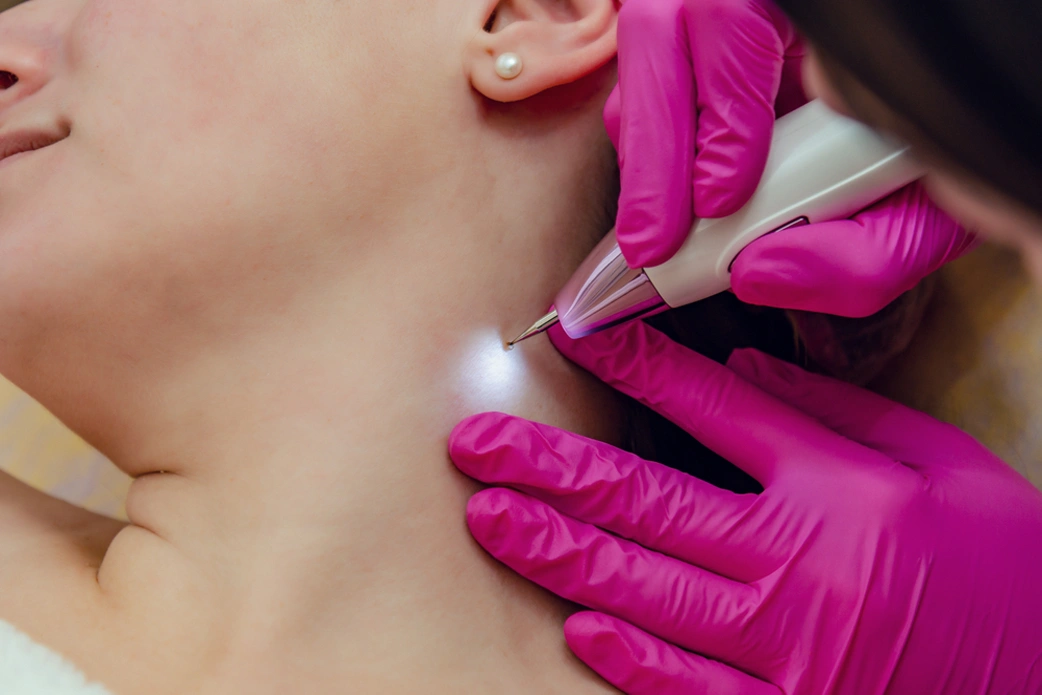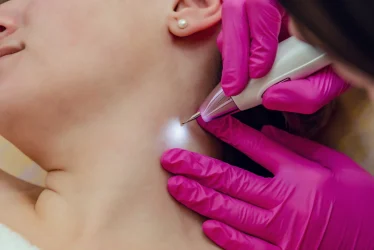Have you ever wondered what those pesky little bumps on your skin are? Well, you’re about to find out! Skin tags are harmless growths that often pop up on various body parts, causing confusion and annoyance for many. But fear not. We’re here to empower you with knowledge and solutions!
Learn about the reasons behind their formation, their potential impact on your daily life, and whether you can safely bid them farewell from the comfort of your home. Let’s demystify these bothersome bumps together!
What Are Skin Tags?
You may have seen them before, but understanding what skin tags are is the first step towards reclaiming your skin’s smoothness. Skin tags are soft, fleshy growths typically appearing where the skin folds or rubs against itself, like the neck, armpits, groin, and under the breasts. While they might seem concerning, skin tags are harmless and not cancerous.
Why Do Skin Tags Form?
Now that we know what they are let’s uncover why these tiny annoyances appear uninvited. Skin tags form due to the friction and pressure when skin repeatedly rubs against skin or clothing.
Age, genetics, and hormonal changes can also contribute to their development. So, while they might seem like they’re playing hide-and-seek, there’s a scientific explanation behind their appearance!
How Can Skin Tags Affect Your Daily Life?
Skin tags might be small, but they can pack a punch when it comes to affecting your daily life. The constant irritation and discomfort they cause can make you feel self-conscious about your appearance, leading to a dip in confidence.
Additionally, their location in areas prone to friction can make activities like wearing certain clothes or accessories, exercising, and even hugging more challenging. But worry not, as we’ll soon explore ways to bid them farewell!
How to Identify Skin Tags?
Before jumping into removal methods, you must deal with skin tags, not other skin conditions. Skin tags usually have a distinct appearance, with a narrow stalk connecting the growth to the skin’s surface.
They are often flesh-coloured or slightly darker and have a soft, smooth texture. If you notice a growth that fits this description, chances are it’s a skin tag. But remember, when in doubt, always consult a healthcare professional for a proper diagnosis.
Is It Safe to Remove Skin Tags at Home?
While the DIY approach may be tempting, safety is paramount for your skin’s health. Removing skin tags at home can be risky, as improper techniques may lead to infection, scarring, or excessive bleeding.
It’s crucial to tread carefully and only attempt removal if you’re certain and have proper guidance. Fortunately, we’ll guide you through safe and effective removal methods, ensuring your skin remains in good hands throughout the process!
When Should You Consider Professional Removal?
While DIY methods for skin tag removal can be tempting, there are certain situations where professional removal is the wisest choice. Here are some scenarios when you should consider seeking help from a healthcare professional:
Multiple or Large Skin Tags – If you have numerous skin tags or some that are particularly large or in sensitive areas, it’s best to have them evaluated and removed by a professional. Large skin tags require more complex removal techniques, and having multiple tags removed at once can be more efficiently and safely done under medical supervision.
High-Risk Locations – Skin tags located in areas with a high risk of complications, such as near the eyes, genitals, or breasts, should be removed by a professional to avoid any potential damage or infection.
Medical Conditions – If you have pre-existing medical conditions or are taking medications, it’s crucial to have a healthcare provider assess the skin tags before attempting removal. Certain conditions or medications might increase the risk of complications during DIY removal.
Cosmetic Concerns – When skin tags are affecting your self-esteem or causing emotional distress, seeking professional removal can provide peace of mind and boost your confidence.
Pain or Bleeding – If a skin tag is painful, irritated, or bleeding, attempting DIY removal could worsen the situation. A healthcare professional can safely address the issue and offer appropriate treatment.
Previous Complications – If you’ve had complications with skin tag removal or experienced adverse reactions, consulting a professional ensures a more successful and safer outcome.
Can Skin Tags Be Cancerous?
One of the most common concerns when dealing with skin tags is whether they can be cancerous. The good news is that skin tags are typically benign and not associated with cancer. They are harmless growths of skin tissue and are not linked to any serious health risks.
However, it’s essential to differentiate between skin tags and other skin growths to ensure peace of mind. If you’re ever unsure about growth, consult a healthcare professional for a proper evaluation.
Why Seeking Medical Advice Is Crucial?
When it comes to your skin’s health, seeking medical advice is always a wise decision. A qualified healthcare professional can accurately diagnose skin tags, ruling out any underlying health concerns.
Moreover, they can offer expert guidance on the best removal approach tailored to your situation. Professional removal minimises risks, ensures proper aftercare, and helps you achieve the desired results safely.
Remember, your skin deserves the best care, and consulting a medical expert is the first step toward a successful skin tag removal journey.
Do Over-The-Counter Products Work?
The market is flooded with over-the-counter products claiming to zap away skin tags overnight. While some may provide temporary relief, it’s essential to approach these products with caution.
The effectiveness of over-the-counter treatments can vary, and they may not be suitable for all types of skin tags. Also, using such products without proper medical guidance can lead to complications or disappointing results.
To avoid frustration and ensure effective removal, it’s best to consult a healthcare professional or explore proven DIY methods backed by scientific research.
Are There Any Potential Side Effects of DIY Removal?
While removing skin tags at home might seem like a cost-effective and convenient solution, it’s essential to be aware of potential side effects. If not performed correctly, DIY removal methods can lead to various complications and adverse outcomes. Here are some potential side effects to consider:
Infection – If the tools used for DIY removal are not properly sterilised, there is a risk of introducing bacteria into the open wound, leading to infection. An infected area may become red, swollen, painful, and even produce pus.
Scarring – Improper removal techniques can cause unnecessary trauma to the skin, resulting in scarring. This may leave behind unsightly marks that take a long time to fade or may be permanent.
Excessive Bleeding – DIY removal methods that involve cutting or tearing the skin tag can lead to excessive bleeding, especially if you have a bleeding disorder or are taking medications that thin your blood.
Pain and Discomfort – Removing skin tags without proper numbing agents or anaesthesia can be painful and uncomfortable. The pain may persist during healing, causing discomfort and hindering your daily activities.
Allergic Reactions – Some home remedies and over-the-counter products may contain ingredients that can trigger allergic reactions, such as redness, itching, and skin swelling.
Incomplete Removal – DIY removal methods may only partially remove the skin tag, causing it to grow back or leading to a more challenging removal process.
Delayed Healing – Without proper aftercare and wound management, the skin tag removal site may take longer to heal, increasing the risk of infection and scarring.
What Are the Different Medical Procedures Available?
When it comes to professionally removing skin tags, doctors have several effective and safe procedures at their disposal. Here are some common medical procedures used for skin tag removal:
Excision – After numbing the area with a local anaesthetic, the specialist uses sterile scissors or a scalpel to cut off the skin tag at its base. The procedure is relatively quick and may require a stitch or two for larger skin tags.
Cauterisation – This technique involves burning the skin tag using an electrical device or a chemical solution. Cauterisation helps to stop bleeding and closes the wound, reducing the risk of infection.
Cryotherapy – Cryotherapy involves freezing the skin tag using liquid nitrogen. The extreme cold destroys the cells in the skin tag, causing it to fall off over time.
Ligation – In ligation, a small band or thread is tied around the base of the skin tag, cutting off its blood supply. Without blood flow, the skin tag eventually dries up and falls off.
Electrodesiccation – This method uses an electric current to dry out and destroy the cells in the skin tag. Similar to cauterisation, electrodesiccation helps to seal the wound and minimise bleeding.
Laser Removal – Laser therapy involves using a focused beam of light to target and remove the skin tag. This precise method may be used for larger or more stubborn skin tags.
Radiofrequency Ablation – Radiofrequency ablation uses radio waves to heat and destroy the cells in the skin tag. The heat also helps coagulate blood vessels, reducing bleeding.
Before proceeding with any medical procedure, your doctor will assess the size, location, and number of skin tags to determine the most appropriate removal method for your case. When performed by trained professionals, these medical procedures are generally quick, effective, and have low risks of complications.
Moreover, medical removal ensures that the skin tag is fully and safely removed, minimising the chances of recurrence and providing you with the best possible results. So, if you’re considering professional removal, rest assured that there are various tried-and-tested techniques to bid farewell to those pesky skin tags once and for all!
What Are the Factors to Consider Before Deciding on a Removal Method?
Before choosing a skin tag removal method, several important factors should be taken into consideration to ensure a safe and successful outcome. Here are the key factors to keep in mind:
Size and Number of Skin Tags – The size and number of skin tags you have can influence the choice of removal method. Larger or multiple skin tags may require more involved procedures, while smaller ones might be better suited for simpler techniques.
Location of Skin Tags – The location of the skin tags plays a significant role in determining the appropriate removal method. Skin tags in visible or sensitive areas, like the face, neck, or genitals, may require more careful consideration to minimise scarring and potential complications.
Pain Tolerance – Some removal methods can be more uncomfortable than others. Consider your pain tolerance and discuss your preferences with your healthcare provider. They can recommend options that align with your comfort level.
Medical History – Your medical history, including any existing health conditions or medications you are taking, should be considered. Certain medical conditions or medications may impact your skin’s healing or increase the risk of complications.
Healing Time – Different removal methods can result in varying healing times. If you need a faster recovery, methods with minimal downtime, such as cryotherapy, may be more suitable.
Cosmetic Concerns – If scarring or changes in your skin’s appearance are a significant concern, discuss this with your healthcare provider. They can recommend methods that are less likely to leave visible marks.
Budget – The cost of skin tag removal can vary depending on the method and the healthcare provider. Consider your budget and explore options that align with your financial situation.
Time and Convenience – Some removal methods may require multiple sessions or visits to the healthcare provider, while others can be done in a single session. Consider your availability and convenience when making your decision.
Medical Professional’s Recommendation – Consulting with a healthcare professional is crucial. They can assess your case, provide expert advice, and recommend the most suitable removal method based on their expertise and experience.
By considering these factors and discussing your concerns with a qualified healthcare provider, you can make an informed decision about the most appropriate skin tag removal method for your specific situation. The goal is to achieve the best possible results while ensuring your safety, comfort, and satisfaction.
When Should You Seek Further Medical Attention?
While skin tag removal is generally straightforward and low-risk, certain situations may warrant further medical attention. If you experience any of the following, it’s essential to reach out to your healthcare provider promptly:
Infection – If the removal site becomes red, swollen, warm to the touch, or develops pus, it could be a sign of infection. Seek medical attention to prevent the infection from worsening.
Excessive Bleeding – Some bleeding after removal is normal, but if the bleeding doesn’t stop or is excessive, it’s essential to contact your healthcare provider immediately.
Allergic Reactions – If you notice any signs of an allergic reaction, such as severe itching, redness, or swelling at the removal site, seek medical attention promptly.
Persistent Pain – While mild discomfort after removal is expected, persistent or severe pain that doesn’t improve with over-the-counter pain relievers may require evaluation by a healthcare professional.
Recurrence – In rare cases, skin tags may grow back after removal. If you notice new skin tags forming at the same location or elsewhere, it’s essential to have them evaluated by a healthcare professional.
Unusual Changes – If you notice any unusual changes in the skin tag or the surrounding area, such as rapid growth, changes in colour, or irregular borders, seek medical attention promptly to rule out any underlying health concerns.
Can Skin Tags Be Prevented?
Prevention is always better than cure, and when it comes to skin tags, there are certain steps you can take to reduce their likelihood of forming. Since skin tags are often linked to friction and skin-on-skin contact, maintaining good hygiene and keeping areas prone to rubbing dry can help.
Maintaining a healthy weight can also reduce the chances of developing skin tags in skin folds. While prevention methods may not guarantee complete avoidance of skin tags, incorporating these practices into your daily routine can make a difference.
What’s the Link Between Skin Tags and Overall Health?
You might be surprised to learn that skin tags can offer some insight into your overall health. Certain health conditions, such as diabetes and metabolic syndrome, have increased the risk of developing skin tags.
Viewing skin tags as potential markers rather than direct causes of underlying health issues is essential. Notice an unusual number of skin tags or other skin changes. Discussing this with your healthcare provider may be a good idea, as it could prompt further evaluation and monitoring of your overall health.
Imagine a life free from the nagging discomfort and self-consciousness caused by those pesky skin tags. Picture yourself radiating with confidence and comfort, ready to tackle any challenge life throws your way. You deserve to live your best life, feeling empowered and beautiful from the inside out!
At NeuGLOW, the AESTHETICS Clinic, we support you on your journey to flawless skin. Our dedicated professionals are committed to providing effective skincare solutions tailored to your unique needs. Trust us to guide you through the process with current equipment and a passion for your safety and satisfaction.
Embrace the power of self-care and let your skin tell a story of empowerment and self-assurance. With NeuGLOW, the AESTHETICS Clinic, by your side, your skin journey is about to reach new heights of confidence and joy. Remember, your beauty is a force to be reckoned with, and we’re here to help you unleash it to the world!







